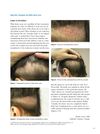TLDR Beard hair can effectively hide hair transplant scars.
The document discusses the use of beard hair as a donor source for camouflaging linear scars resulting from follicular unit hair transplant (FUHT). The linear scar, which is a continuous line of bald skin, poses a cosmetic challenge as it is easily visible and requires longer hairstyles to cover. The study found that beard hair, despite being shorter than scalp hair, can provide adequate coverage for these scars. Over 60 patients were selected for this procedure, with one example showing that after 10 months, approximately 1200 transplanted beard hairs made the strip scar no longer visible. The procedure involves using local anesthesia and custom-sized blades for grafting, with the donor beard hair being harvested from below the jawline and, if necessary, from the cheeks and sideburns. The document also notes that patients may experience hypopigmentation at the extraction site and transient mild paresis of oral mimetic muscles due to local anesthetics. The conclusion is that beard hair transplantation is a viable option for repairing strip scars in patients with adequate beard hair.
20 citations
,
February 2012 in “Archives of dermatology” Leg hair transplants can create a natural-looking hairline and show successful growth over several years.
 25 citations
,
May 2011 in “Annals of Plastic Surgery”
25 citations
,
May 2011 in “Annals of Plastic Surgery” Nonhead hair transplantation is effective for patients with limited head donor hair, but more research is needed.
 11 citations
,
June 2008 in “Dermatologic Surgery”
11 citations
,
June 2008 in “Dermatologic Surgery” Transplanting chest hair into scalp scars may effectively treat wide donor scars in hair restoration.
 3 citations
,
May 2019 in “Medical Hypotheses”
3 citations
,
May 2019 in “Medical Hypotheses” A new hair transplant method suggests freezing and storing dense hairs for future use to address severe hair loss.
2 citations
,
September 2017 Hair and scalp diseases can affect hair transplant success in Asians, and managing them is crucial.
 32 citations
,
July 2011 in “Facial Plastic Surgery”
32 citations
,
July 2011 in “Facial Plastic Surgery” New hair transplant methods offer more natural results and better graft survival, with ongoing research to increase donor hair options.
 15 citations
,
December 2007 in “Dermatologic Therapy”
15 citations
,
December 2007 in “Dermatologic Therapy” Hair transplantation has improved with techniques that increase graft survival and patient satisfaction for more natural results.
January 2004 in “Chinese Journal of Medical Aesthetics and Cosmetology” Hair transplantation is effective for seborrheic hair loss if done carefully.
 24 citations
,
September 2002 in “Dermatologic Surgery”
24 citations
,
September 2002 in “Dermatologic Surgery” The place where hair is transplanted can affect its growth and survival rates.
2 citations
,
May 2002 in “PubMed” Micro-graft hair transplantation is an effective, simple, and painless method for permanent hair restoration in men and women.






